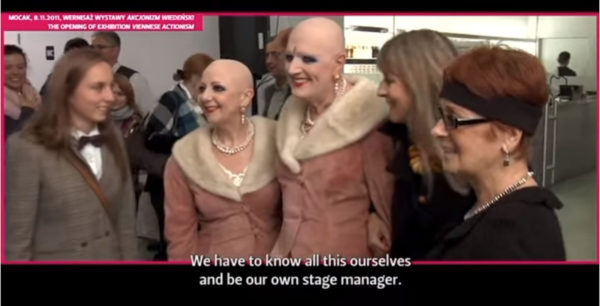When they write the official history of artists who experimented with gender fluidity, Eva & Adele should rightfully get their own chapter. At an art fair or posh party over the last three decades, you may have encountered a pair of bald ladies attired in identical pink frocks, posing for photographs with tourists. What would have escaped your notice, if you didn’t dig deeper, is that these two ladies consider themselves to be artworks. The concepts that underlie their work are solid. Watching them live as artworks in the 2015 documentary EVA & ADELE Gesamtkunstwerk can be exhausting. Their work ethic is relentless.
Nobody knows where they came from or how old they are. Their official story is that they arrived in a time machine from the future in 1989, when the Berlin Wall fell. They refer to their activities as “FUTURING.” Their initial “manifesto” was a series of logos that look like postmarks, which pretty well lay out their agenda: “Wherever We are is Museum,” “Art of Nature, Nature of Art,” “The Beginning After the End of Art.” When they started producing physical artworks, these slogans were incorporated into the imagery.
What is known of their history starts in the very early ’90s. They staged a mock wedding in which they were both brides in 1991 and toured around rural Europe in a pink camper van, interacting with the people they met without “breaking character.” Being a man and woman, nothing prevented them from legally marrying, but they went to a German court and got Eva declared female (with no surgery or body modifications). Once Eva was officially female, they married as women. In a Guardian profile, they proudly beam: “We Invented Our Own Sex!”
They never leave the house without being fully attired and painted. When trips to the dentist made lipstick a tricky proposition, they formulated a special makeup paint that wouldn’t smear. Getting ready for the day is a three-hour process that involves shaving, makeup and putting on all the elements of their identical outfits. The last step is the daily self-portrait. In addition to the self-portraits, a huge part of their early work involved the portraits that other people took of them. Watching them interact with art fair attendees, it becomes clear that they are both charming and articulate. It might be easy to scoff at the amount of pink that colors both their attire and art, until they explain the pink triangles of Nazi Germany. All those clothes and accessories might not seem serious until you get a peek at the ledger they use to plan their costumes. An outfit might include 20 elements, and there might be multiple outfits in a day. Their reason for all this planning is that they don’t want to be thinking about their outfits when they are talking art theory. Over the last decade they have become fixtures on gallery walls too. Next stop: Art History!


